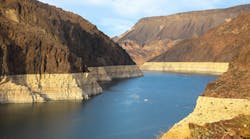About the author: Kevin Simpson is a senior project manager for YSI, a Xylem brand. Simpson can be reached at [email protected].
Organizations around North America embark on storm water monitoring projects for a variety of reasons. Given ever-encroaching human development and its impact on the environment, it is now more important than ever to monitor the effect of storm water runoff on ecosystems.
Storm water monitoring can range from simple rainfall and turbidity measurements typically encountered during construction projects to complex multiparameter sites monitoring open-channel flow, level, rainfall and various water quality parameters such as pH, temperature, conductivity, dissolved oxygen, turbidity and nutrients. No matter the size or scope, the primary purpose of any storm water monitoring effort is to protect our planet and communities.
One Size Does Not Fit All
The criteria for and scope of storm water monitoring projects varies depending on state, federal and local government compliance initiatives and the type of public and private organizations involved. No matter the driving force, there is no standard, “off the shelf” solution that organizations can snap into place. Monitoring efforts require customized solutions based on each organization’s specific needs and budgets, and each monitoring site’s unique application and installation challenges as they relate to the adjacent watershed.
Bring In The Experts
It is important to note that these are not DIY projects, and it has become common practice to bring in a manufacturer and/or environmental consultant to help with the project design and execution. These application professionals can guide you through the process of choosing a versatile, logic-based data acquisition (and if necessary, control) system capable of measuring all of the required parameters, and choosing a field-proven integrated system best suited for each site’s specific monitoring challenges. Bringing in a professional will avoid misuse of valuable field resource time, missed sampling routines, improper equipment/sensor selection, data discrepancies, and most importantly, costly compliance violations down the road.
Step-By-Step Process
Precipitation & Level Sensor. One of the most common storm water event triggers is a rainfall and/or combination water level increase event during a specified time duration.
A standard for rainfall measurement is a tipping bucket rain gauge with a 0.01-in. resolution and 8-in. orifice. Location, mounting and maintenance of this sensor are critical for accurate data.
Water level can be measured using a variety of sensor-based methods with varying accuracy, power and signal output requirements, as well as specific mounting/securing requirements. These include:
- Pressure transducer;
- Bubbler;
- Radar sensor;
- Acoustic sensor; and
- Shaft encoder.
Event Criteria & Automation. These are important to consider, as they will act as the central processor and remote interface to your site. One common choice is the standard utilization of a data collection platform where the same datalogger/controller is used through all sites within the network.
This datalogger/controller should provide the versatility to:
- Configure the criteria for event triggers;
- Provide routine data acquisition through cellular communication;
- Have a software utility cable running on your organization’s PC or server, or have access to a professionally hosted site (ideal for remote personnel and/or multi-organizational access);
- Provide two-way control and configuration access to the site;
- Provide alarm/event trigger notification through e-mail and/or text messaging service; and
- Expand with your organization’s monitoring needs.
Event-Based Water Sampling. Select a water sampler for either discrete or composite sampling. An ideal combination is a reputable manufacturer and a robust, easy-to-use portable sampler capable of receiving a simple trigger from your universal datalogger/control module to execute the sampling routine once the event criteria has been achieved.
Notification. There are several reasons to consider a data collection system enabled with real-time communication. The first and perhaps most important is the automatic notification that event criteria at a specific site have been met. Notification is typically delivered through e-mail or text message to a specific subscriber group.
Another key reason for having real-time access and automated data delivery from a network is the assurance that all sites are functioning nominally, with adequate power reserves, and are collecting quality data. Without the ongoing notification, collection systems can be out of order for days or even weeks if not checked by field teams, and valuable data would be lost.
Water Quality. Organizations required to monitor specific water quality parameters will want to consider a multiparameter instrument, which can be configured with common sensors providing data output to your datalogger/controller for temperature, pH, conductivity, dissolved oxygen, turbidity, depth and chlorophyll, as well as several other sensors and calculated parameters. It is important to consider an instrument that can meet your current measurement needs, but also has the capacity to be expanded and/or reconfigured with other sensors in the future.
Flow Monitoring. Flow proportional sampling is another common requirement for discrete and composite water sampling. This is perhaps the most challenging of all requirements and entails proper channel surveying, placement in a non-full pipe and mounting in natural streams with shifting sediment beds.
An ideal solution for these applications is an acoustic Doppler sensor, capable of measuring the entire cross-section of the flow profile and able to address the active water level fluctuation range.
Traditional methods of measuring flow tend to be less portable, are more intrusive to the discharge conduit, are unable to measure bidirectional flow and typically are more expensive to engineer and install.
Getting It Done
Storm water monitoring to address compliance does not have to be a burden to your organization. With proper planning at the outset and the appropriate steps for equipment selection throughout the process, a scalable, real-time data collection and logic-based control platform will provide the versatility necessary for years of monitoring success.
Download: Here


